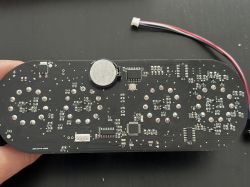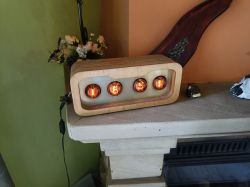Hello forum users,
I present the finished design of a watch based on IN-1 + INS-1 tubes

The project assumed the greatest possible compactness of the control electronics while using the most common elements.
So I decided on a surface mount project, using the DS3231 as a real time clock, the watch code is contained in the ATmega328 present on the PCB as an integrated Arduino UNO, hence the presence of the CH340G on board and the possibility of programming at any time via the USB C port, which also serves as power.
The tubes are controlled by two multiplexing 74HC595 registers connected to MMBTA42 and MMBTA92 transistors.
The 170 V boost converter is a ready-made system purchased from our friends from the east.
On the board, in the possible need for development, there are 3 free Arduino ports that can be used as inputs/outputs (buttons, alarm clock buzzer, etc.)
The colon, of course, serves as the second hand.


The shape of the printed circuit board was created with the intention of making a watch case, but the woodwork is still ahead of me. :)
What do you think? I'm interested in your opinions.
I present the finished design of a watch based on IN-1 + INS-1 tubes

The project assumed the greatest possible compactness of the control electronics while using the most common elements.
So I decided on a surface mount project, using the DS3231 as a real time clock, the watch code is contained in the ATmega328 present on the PCB as an integrated Arduino UNO, hence the presence of the CH340G on board and the possibility of programming at any time via the USB C port, which also serves as power.
The tubes are controlled by two multiplexing 74HC595 registers connected to MMBTA42 and MMBTA92 transistors.
The 170 V boost converter is a ready-made system purchased from our friends from the east.
On the board, in the possible need for development, there are 3 free Arduino ports that can be used as inputs/outputs (buttons, alarm clock buzzer, etc.)
The colon, of course, serves as the second hand.


The shape of the printed circuit board was created with the intention of making a watch case, but the woodwork is still ahead of me. :)
What do you think? I'm interested in your opinions.
Cool? Ranking DIY






